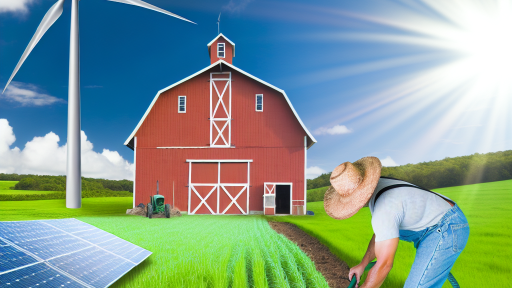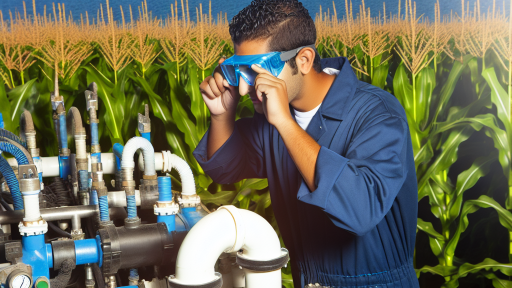Introduction to Renewable Energy in Agriculture
Renewable energy plays a vital role in modern agriculture.
Farmers increasingly seek sustainable solutions to combat climate change.
Utilizing renewable energy technologies can enhance farm efficiency.
These solutions help reduce greenhouse gas emissions significantly.
The Importance of Renewable Energy
Energy consumption in agriculture contributes heavily to carbon emissions.
Renewable resources provide farmers with cleaner alternatives.
This transition supports environmental sustainability initiatives.
Types of Renewable Energy Sources
Several renewable energy sources are available for farms.
- Solar energy harnesses sunlight for electricity and heating.
- Wind energy captures air currents to generate power.
- Biomass utilizes organic materials to produce fuel and energy.
- Geothermal energy taps into the Earth’s heat for various applications.
Benefits of Renewable Energy in Agriculture
Implementing renewable energy offers numerous advantages.
Firstly, it lowers energy costs over time.
Additionally, it improves energy security by diversifying resources.
Moreover, renewable energy enhances farm resilience to changing climates.
By adopting these solutions, farmers can also increase public support.
This aligns agriculture with broader environmental goals.
Challenges in Adoption
However, challenges remain in integrating renewable energy.
Transform Your Agribusiness
Unlock your farm's potential with expert advice tailored to your needs. Get actionable steps that drive real results.
Get StartedInitial investment costs can be prohibitive for some farmers.
Furthermore, the availability of technology may vary by location.
Education and training also play crucial roles in successful adoption.
Farmers need access to information about best practices and technologies.
Benefits of Renewable Energy for Climate-Smart Farming
Reducing Greenhouse Gas Emissions
Renewable energy significantly reduces greenhouse gas emissions.
This transition is crucial for combating climate change.
Farms utilizing wind, solar, or biomass power lower their carbon footprints.
Consequently, they contribute to a healthier environment.
Enhancing Energy Independence
Using renewable energy sources allows farms to gain energy independence.
Farmers reduce their reliance on fossil fuels and volatile markets.
This independence ensures stability in energy costs over time.
Moreover, local energy production keeps funds within the community.
Increased Resilience to Climate Change
Renewable energy offers increased resilience against climate disruptions.
Farmers can maintain operations during power outages.
This reliability is increasingly vital in extreme weather conditions.
Moreover, diversified energy sources bolster farm sustainability.
Cost Savings and Economic Benefits
Investing in renewable energy can lead to substantial cost savings.
Once established, these systems often have lower operational costs.
In addition, grants and incentives boost economic viability.
As a result, farms can improve their financial health long-term.
Supporting Soil Health and Biodiversity
Renewable energy practices can promote better soil health.
By reducing pollution, farmers enhance the vitality of soil ecosystems.
Furthermore, diversified farming methods increase biodiversity.
This approach fosters resilient agricultural practices for future generations.
Showcase Your Farming Business
Publish your professional farming services profile on our blog for a one-time fee of $200 and reach a dedicated audience of farmers and agribusiness owners.
Publish Your ProfilePromoting Innovative Farming Techniques
Adopting renewable energy fosters innovation within farming practices.
Farmers explore cutting-edge technology to maximize resource efficiency.
Technologies such as precision agriculture benefit from renewable setups.
Consequently, this leads to higher yields and reduced waste.
Solar Power Options for Farms: Installation and Cost Efficiency
Benefits of Solar Power for Farms
Solar power offers farms a sustainable energy source.
It reduces reliance on grid electricity.
Additionally, solar energy lowers utility costs over time.
Moreover, it reduces carbon footprints significantly.
Types of Solar Installations
Agricultural operations can utilize different solar options.
Rooftop solar panels are common for barns and warehouses.
Ground-mounted solar systems suit larger spaces.
Farmers can also consider solar carports for added benefits.
Battery storage systems complement solar installations well.
Installation Process
First, assess site suitability for solar panels.
Next, choose a reputable installer who understands farm needs.
In addition, verify necessary permits for installation.
Then, installation typically follows a detailed plan.
Finally, connect the system to the existing electrical network.
Cost Efficiency of Solar Power
Initial installation costs can be high, but savings accumulate.
Federal and state incentives often assist with upfront expenses.
Over time, energy savings can surpass installation costs.
Furthermore, solar panels require minimal maintenance.
Lastly, many farmers report increased property values after installation.
Financing Options
Farmers have various avenues for financing solar projects.
Loans specifically for renewable energy projects are widely available.
In addition, power purchase agreements facilitate cost management.
Leasing options can also spread out installation costs.
Moreover, community solar projects enable shared investment opportunities.
Delve into the Subject: Solar-Powered Irrigation Systems for Efficient Water Use
Wind Energy Utilization on Agricultural Land
Introduction to Wind Energy in Agriculture
Wind energy has emerged as a viable renewable resource for farms.
This alternative energy source offers sustainable solutions for farmers.
Moreover, it helps reduce dependency on fossil fuels.
Benefits of Wind Energy for Farmers
Wind energy can significantly lower energy costs for agricultural operations.
Utilizing wind power decreases greenhouse gas emissions.
In addition, farmers can generate additional income through energy sales.
Thus, investing in wind energy enhances farm profitability.
Assessing Land Suitability for Wind Turbines
Not all agricultural lands are ideal for wind energy production.
Farmers must assess wind patterns and land elevation.
In addition, proximity to transmission lines affects feasibility.
Conducting an energy assessment provides vital information for farmers.
Showcase Your Farming Business
Publish your professional farming services profile on our blog for a one-time fee of $200 and reach a dedicated audience of farmers and agribusiness owners.
Publish Your ProfileIntegrating Wind Turbines into Farming Practices
Wind turbines can coexist with traditional farming practices.
Many farmers integrate turbines into their existing land systems.
For instance, crops can be planted around turbine bases.
This approach maximizes land use while generating energy.
Case Studies of Successful Implementations
Successful examples exist in various regions across the country.
The Wilson Family Farm in Nebraska utilizes wind energy effectively.
They generated enough power to supply their operations and sell excess energy.
Similarly, the Green Acres Farm in Iowa illustrates the benefits of wind integration.
Challenges and Considerations
Despite its advantages, wind energy adoption faces challenges.
Initial investment costs for turbines can be substantial.
Additionally, farmers must navigate local regulations and zoning laws.
It’s essential to evaluate long-term benefits against upfront costs.
Future of Wind Energy in Agriculture
The future appears bright for wind energy in agriculture.
Technological advancements continue to improve turbine efficiency.
As awareness grows, more farmers will explore renewable options.
Ultimately, wind energy can play a significant role in sustainable farming.
See Related Content: Transitioning to Renewable Energy in Agriculture
Biogas Production from Farm Waste
Introduction to Biogas
Biogas is a renewable energy source derived from organic materials.
This process conversion occurs in the absence of oxygen, known as anaerobic digestion.
Farm waste, including manure and crop residues, serves as an ideal feedstock.
Farmers utilize biogas systems to generate clean energy and reduce waste.
The Biogas Production Process
The biogas production process involves several key steps.
First, farmers collect organic waste to be processed.
Next, they place the waste in a sealed digester.
The digester creates an anaerobic environment, preventing oxygen from entering.
Microorganisms then break down the organic material over time.
This breakdown produces biogas, mainly consisting of methane and carbon dioxide.
Finally, farmers can capture and utilize this gas for various purposes.
Benefits of Biogas Production
Biogas production offers numerous benefits for farmers and the environment.
First, it reduces the dependency on fossil fuels.
This approach lowers greenhouse gas emissions, promoting cleaner air.
Additionally, biogas can improve energy security for farms.
Farmers can use it to generate electricity or heat.
Moreover, digestate, a byproduct of biogas production, acts as a nutrient-rich fertilizer.
This fertilizer enhances soil health while minimizing chemical use.
Lastly, biogas systems help reduce waste and improve farm sustainability.
Uncover the Details: Wind Energy Solutions for Modern Farming Practices

Geothermal Energy Applications in Agriculture
Introduction to Geothermal Energy
Geothermal energy harnesses heat from the Earth’s core.
This sustainable energy source provides numerous advantages for farms.
It can significantly reduce energy costs and carbon emissions.
Showcase Your Farming Business
Publish your professional farming services profile on our blog for a one-time fee of $200 and reach a dedicated audience of farmers and agribusiness owners.
Publish Your ProfileHeating Greenhouses
Farmers can use geothermal energy to heat greenhouses year-round.
This approach promotes optimal growth conditions for plants.
As a result, farmers produce higher quality crops with better yields.
Soil Heating for Crop Production
Geothermal energy can also heat the soil in crop fields.
Warmed soil accelerates plant growth and extends the growing season.
This technique is particularly beneficial in colder climates.
Livestock Management
Geothermal systems can provide warmth for livestock facilities.
Maintaining a stable temperature supports animal health and productivity.
This practice helps prevent cold-stress in winter months.
Enhanced Water Management
Farmers can employ geothermal energy for heating irrigation water.
Warm water enhances nutrient uptake in plants.
This method can assist in managing plant diseases effectively.
Ground Source Heat Pumps
Ground source heat pumps utilize geothermal energy efficiently.
These pumps provide both heating and cooling for agricultural buildings.
They improve overall energy efficiency and create a comfortable work environment.
Cost-Effectiveness and Long-Term Advantages
Initial investments in geothermal systems can be high.
However, long-term savings on energy costs pay off significantly.
Additionally, farms benefit from improved sustainability practices.
Challenges and Considerations
Implementation of geothermal systems comes with challenges.
Site-specific assessments are necessary to evaluate resources.
Farmers must weigh costs against potential savings carefully.
Case Studies of Successful Geothermal Farms
Several farms demonstrate successful geothermal energy applications.
For instance, River Valley Farms uses geothermal heating effectively.
This facility reported enhanced crop growth and reduced expenses.
Future of Geothermal Energy in Agriculture
The future looks promising for geothermal energy in farming.
Continued advancements in technology will expand its applications.
As farmers embrace sustainability, geothermal energy will play a vital role.
Uncover the Details: Cost-Effective Adaptations for Climate-Smart Farming
Integration of Renewable Energy Solutions into Existing Farming Practices
Understanding Renewable Energy Sources
Renewable energy sources include solar, wind, geothermal, and biomass.
Farmers can utilize these resources to power their operations.
This shift reduces reliance on fossil fuels.
Moreover, using renewables can lower operational costs.
Evaluating Energy Needs
The first step is assessing the farm’s energy requirements.
Farmers should analyze current energy consumption patterns.
They can identify potential areas for energy savings.
Next, consider the type of renewable energy solutions best suited for the farm.
Implementing Solar Energy Solutions
Solar panels can be installed on rooftops or in open fields.
They capture sunlight and convert it into electricity.
This energy can power irrigation systems and greenhouses.
Farmers may also sell excess energy back to the grid.
Showcase Your Farming Business
Publish your professional farming services profile on our blog for a one-time fee of $200 and reach a dedicated audience of farmers and agribusiness owners.
Publish Your ProfileUtilizing Wind Energy
Wind turbines are another excellent renewable option.
They generate electricity through wind motion.
This energy source is particularly effective in open areas.
Farmers should evaluate wind patterns on their land before installation.
Incorporating Biomass Energy
Biomass energy comes from organic materials, such as crop waste.
This waste can be converted into biogas or biofuel.
Farmers can use these fuels for heating or generating electricity.
This process minimizes waste and boosts sustainability.
Optimizing Energy Efficiency
Integrating renewable energy requires energy efficiency measures.
Farmers should upgrade equipment to more efficient models.
Additionally, implementing smart energy management systems can aid monitoring.
These practices further reduce energy consumption and costs.
Engaging in Community Solar Projects
Community solar projects expand access to renewable energy.
These initiatives allow multiple farmers to share resources.
Pooling investments can lead to significant cost savings.
Participating in such projects fosters community collaboration.
Accessing Financial Incentives
Many governments offer incentives for renewable energy investments.
Farmers should research available grants and tax credits.
These financial aids can significantly lower upfront costs.
Ultimately, they encourage more sustainable farming practices.
Case Studies of Successful Renewable Energy Implementations in Farming
Solar Power Integration in Organic Farms
Sunny Acres Organic Farm dramatically reduced its energy expenses by installing solar panels.
The farm now generates its own electricity with renewable energy.
This move significantly cuts its carbon footprint and energy bills.
Moreover, it sells surplus energy back to the grid, generating additional income.
Farmers report feeling empowered by their energy independence.
Wind Energy Utilization in Crop Production
Windswept Fields implemented wind turbines to harness wind energy.
This innovative strategy provides power for irrigation and machinery.
The outcome includes reduced reliance on fossil fuels.
This transition enhances sustainability and lowers operational costs.
Additionally, farmers reported a positive community response to their green initiatives.
Bioenergy Sources on Livestock Farms
Green Pastures Ranch embraced bioenergy by converting waste to energy.
They utilize manure to produce biogas, which fuels heating systems.
This process efficiently manages waste while producing renewable energy.
Importantly, it also minimizes environmental pollution from livestock operations.
The farm has become a model for sustainable livestock farming.
Geothermal Energy in Greenhouses
Hilltop Greenhouses use geothermal energy to maintain optimal temperatures for crops.
By tapping into underground heat, they reduce their heating costs significantly.
This system ensures year-round production of high-quality vegetables.
Farmers appreciate the stable climate for their plants, leading to increased yields.
Additionally, it showcases innovation within the agricultural sector.
Showcase Your Farming Business
Publish your professional farming services profile on our blog for a one-time fee of $200 and reach a dedicated audience of farmers and agribusiness owners.
Publish Your ProfileHydroponics Powered by Renewable Sources
Fresh Start Farms combines hydroponics with solar energy and rainwater harvesting.
This approach optimizes resource use while minimizing waste.
Farmers can grow fresh produce efficiently and sustainably.
The farm also serves educational purposes, teaching others about renewable technologies.
Local communities benefit from improved access to fresh, healthy food.
Additional Resources
Climate Change Impacts on Agriculture and Food Supply | US EPA




